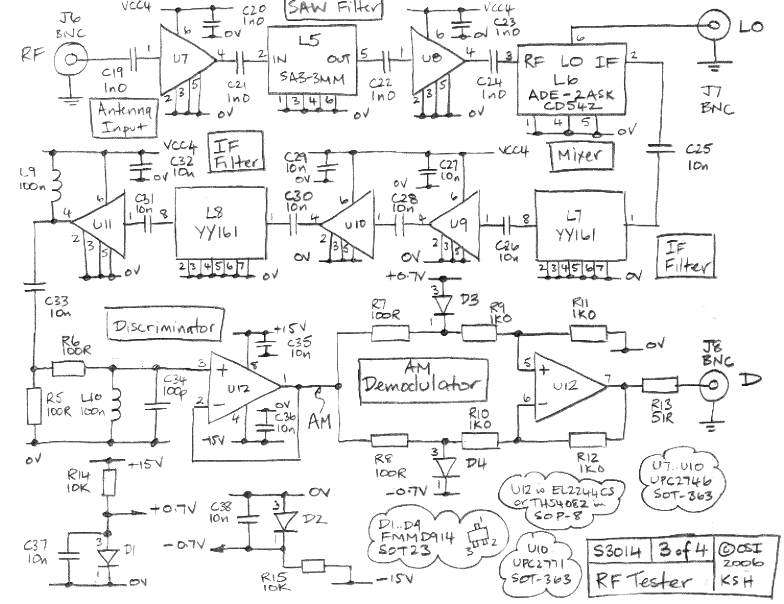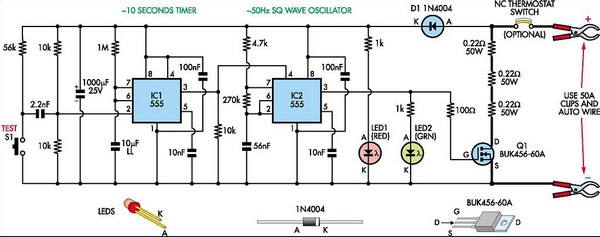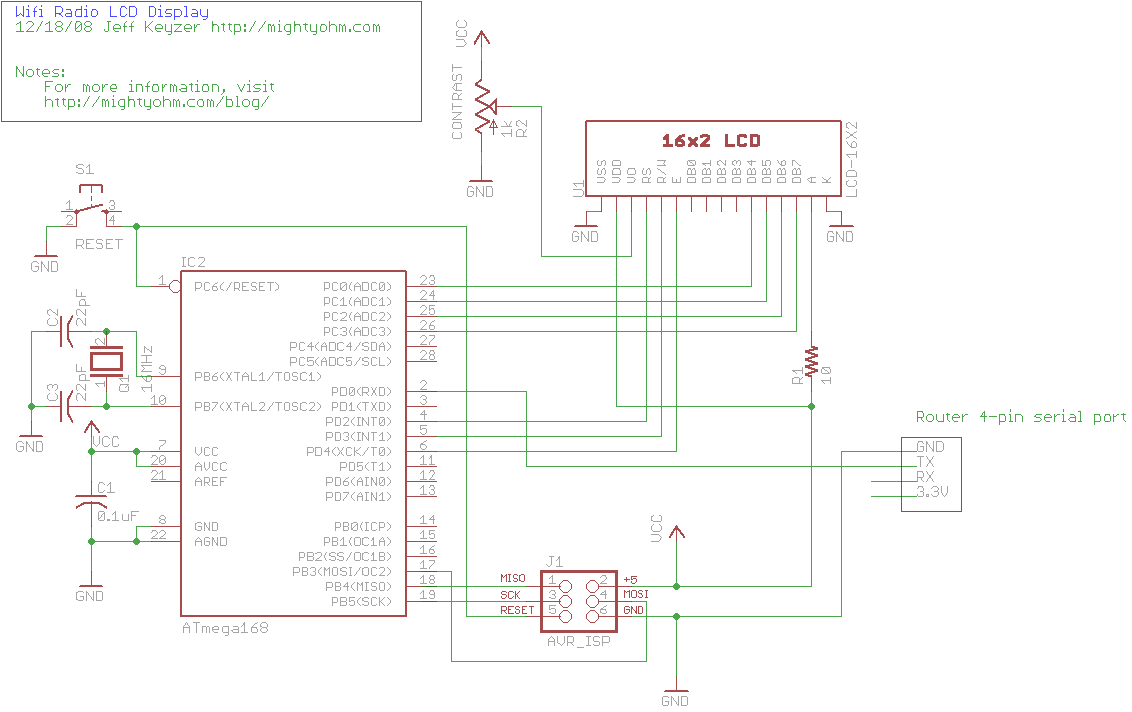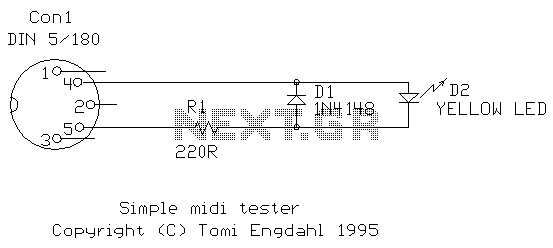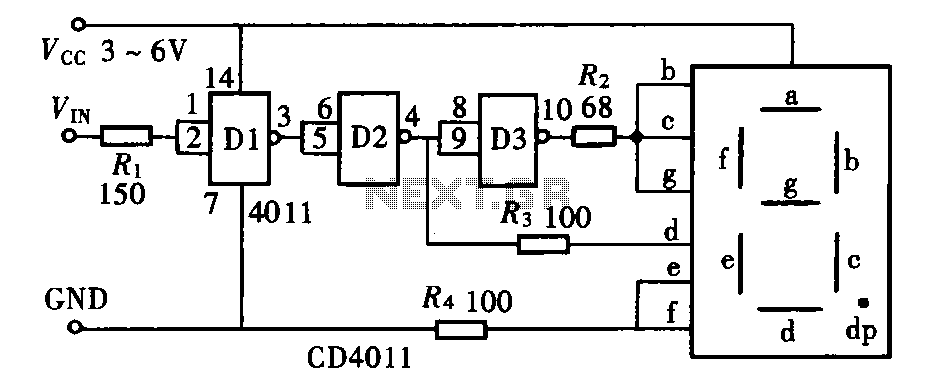
Liquid-Crystal Display (LCD) Tester
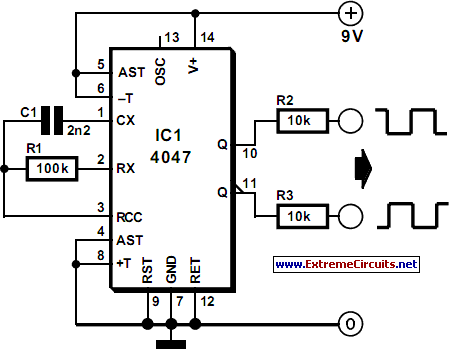
Liquid-crystal displays (LCDs) are available in various sizes and configurations, including their pinouts. Many of these displays require the manufacturer's documentation for proper usage, which is often difficult to locate when needed. Consequently, a small tester designed to identify the terminals can be quite useful. An LCD is composed of two thin glass sheets, with conductive tracks applied to their inner surfaces. These tracks are typically invisible when viewed from a straight or nearly straight angle but become visible at certain angles. The space between the glass sheets is filled with a liquid that, when stimulated by an electric voltage, changes the polarization of incoming light. This mechanism allows segments of the display to appear either light or dark, forming lines or shapes. To test a segment, an alternating voltage of a few volts should be applied. It is crucial to avoid direct voltage, as it can cause irreversible damage to the display by removing the conductive tracks. The alternating voltage must not contain any direct voltage component. Although alternating current can also damage the tracks when flowing in one direction, it can restore them when flowing in the opposite direction. The described tester utilizes a square-wave generator that produces a perfectly symmetrical alternating voltage without any direct current (DC) component. Most logic oscillators cannot generate a true square wave, instead producing rectangular waveforms with a duty cycle around 50%. The 4047 integrated circuit used in the tester features a binary scaler at its output, ensuring signal symmetry. The oscillator operates at approximately 1 kHz and can be powered by a 3–9 V source. Typically, this source is a battery, although a variable power supply offers advantages, such as indicating the voltage at which the display operates optimally and demonstrating the relationship between voltage levels and the clarity of the display at various angles. The tester consumes a current of no more than 1 mA. The test voltage must always be applied between the common terminal, or back plane, and one of the segments. If the back plane terminal is unknown, one probe of the tester should be connected to a segment while the other probe is successively connected to all other terminals until the segment becomes visible. It is important to note that some LCDs may have multiple back planes; therefore, if a segment does not become visible, it is advisable to check for an additional back plane terminal.
The operation of liquid-crystal displays relies on the precise interaction between the applied voltage and the liquid crystal material. This material is sensitive to electric fields, allowing for the manipulation of light passing through the display. The tester's square-wave generator is essential for maintaining the integrity of the display during testing. By ensuring that the voltage applied is purely alternating, the risk of damaging the display is minimized. The choice of the 4047 IC is strategic, as it not only enables the generation of a symmetrical waveform but also provides flexibility in frequency selection, which can be adjusted based on the specific requirements of the LCD being tested.
The design of the tester should include a user-friendly interface, possibly with indicator LEDs to signal when a segment is activated. Additionally, incorporating a variable resistor in the circuit allows for fine-tuning of the voltage applied, facilitating the exploration of the display's operational range. Proper grounding and shielding techniques should be employed to prevent interference and ensure accurate readings. The layout of the circuit should be compact yet robust, with attention to the placement of components to minimize noise and enhance performance. Overall, the tester serves as an invaluable tool for diagnosing and troubleshooting liquid-crystal displays, providing insights into their functionality without risking damage to the components.Liquid-crystal displays come in all sorts and sizes, and this applies also to their pinouts. In fact, many of these displays cannot be used properly without the manufacturers` documentation. But, of course, this can never be found when it is needed, and a small tester to unravel the terminals may, therefore, be found very handy. A liquid-crystal d isplay consists of two thin sheets of glass, the facing surfaces of which have been given thin conducting tracks. When the glass is looked through at right or near-right angles, these tracks cannot be seen. At certain viewing angles, they become visible, however. The space between the sheets of glass is filled with a liquid that, stimulated by an electric voltage, alters the polarization of the incident light.
In this way, segments may appear light or dark and give rise to the display of lines or shapes. A segment may be tested by applying an alternating voltage of a few volts across it. Note that the application of a direct voltage will damage the display irreversibly: the resulting current will remove the tracks. The alternating voltage should contain not even a tiny direct voltage component. An alternating current also removes part of the tracks when the current flows in one direction, but restores it when the current flows in the opposite direction.
The tester described here consists of a square-wave generator that produces an absolutely symmetrical alternating voltage without any d. c. component. Most logic oscillators are incapable of producing a squarewave signal: they generate rectangular waveforms whose duty cycle hovers around the 50%.
The 4047 used in the tester has a binary scaler at its output that guarantees symmetry. The oscillator frequency is about 1 kHz. It may be powered from a 3 9 V source. Normally, this will be a battery, but a variable power supply has advantages. It shows at which voltage the display works satisfactorily and also that there is a clear relationship between the level of the voltage and the angle at which the display is clearly legible. The tester draws a current not exceeding 1 mA. The test voltage must at all times be connected between the common terminal, that is, the back plane, and one of the segments.
If it is not known which of the terminals is the back plane, connect one probe of the tester to a segment and the other successively to all the other terminals until the segment becomes visible. Note, however, that there are LCDs with more than one back plane. Therefore, if a segment does not become visible, investigate whether the display has a second back plane terminal.
🔗 External reference
The operation of liquid-crystal displays relies on the precise interaction between the applied voltage and the liquid crystal material. This material is sensitive to electric fields, allowing for the manipulation of light passing through the display. The tester's square-wave generator is essential for maintaining the integrity of the display during testing. By ensuring that the voltage applied is purely alternating, the risk of damaging the display is minimized. The choice of the 4047 IC is strategic, as it not only enables the generation of a symmetrical waveform but also provides flexibility in frequency selection, which can be adjusted based on the specific requirements of the LCD being tested.
The design of the tester should include a user-friendly interface, possibly with indicator LEDs to signal when a segment is activated. Additionally, incorporating a variable resistor in the circuit allows for fine-tuning of the voltage applied, facilitating the exploration of the display's operational range. Proper grounding and shielding techniques should be employed to prevent interference and ensure accurate readings. The layout of the circuit should be compact yet robust, with attention to the placement of components to minimize noise and enhance performance. Overall, the tester serves as an invaluable tool for diagnosing and troubleshooting liquid-crystal displays, providing insights into their functionality without risking damage to the components.Liquid-crystal displays come in all sorts and sizes, and this applies also to their pinouts. In fact, many of these displays cannot be used properly without the manufacturers` documentation. But, of course, this can never be found when it is needed, and a small tester to unravel the terminals may, therefore, be found very handy. A liquid-crystal d isplay consists of two thin sheets of glass, the facing surfaces of which have been given thin conducting tracks. When the glass is looked through at right or near-right angles, these tracks cannot be seen. At certain viewing angles, they become visible, however. The space between the sheets of glass is filled with a liquid that, stimulated by an electric voltage, alters the polarization of the incident light.
In this way, segments may appear light or dark and give rise to the display of lines or shapes. A segment may be tested by applying an alternating voltage of a few volts across it. Note that the application of a direct voltage will damage the display irreversibly: the resulting current will remove the tracks. The alternating voltage should contain not even a tiny direct voltage component. An alternating current also removes part of the tracks when the current flows in one direction, but restores it when the current flows in the opposite direction.
The tester described here consists of a square-wave generator that produces an absolutely symmetrical alternating voltage without any d. c. component. Most logic oscillators are incapable of producing a squarewave signal: they generate rectangular waveforms whose duty cycle hovers around the 50%.
The 4047 used in the tester has a binary scaler at its output that guarantees symmetry. The oscillator frequency is about 1 kHz. It may be powered from a 3 9 V source. Normally, this will be a battery, but a variable power supply has advantages. It shows at which voltage the display works satisfactorily and also that there is a clear relationship between the level of the voltage and the angle at which the display is clearly legible. The tester draws a current not exceeding 1 mA. The test voltage must at all times be connected between the common terminal, that is, the back plane, and one of the segments.
If it is not known which of the terminals is the back plane, connect one probe of the tester to a segment and the other successively to all the other terminals until the segment becomes visible. Note, however, that there are LCDs with more than one back plane. Therefore, if a segment does not become visible, investigate whether the display has a second back plane terminal.
🔗 External reference
